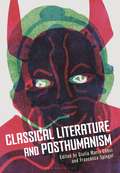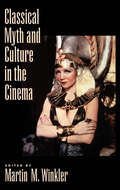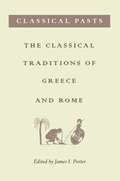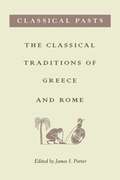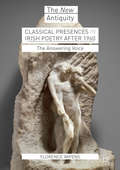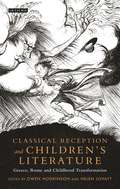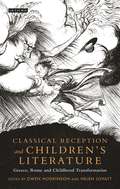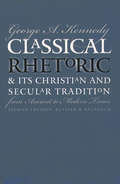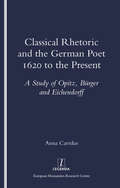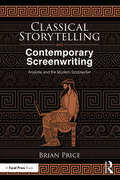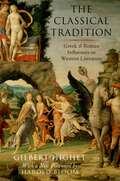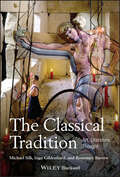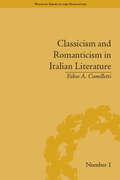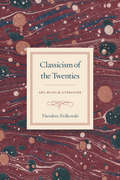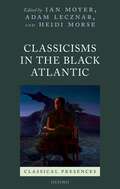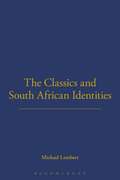- Table View
- List View
Classical Literature and Posthumanism
by Giulia Maria Chesi Francesca SpiegelThe subject of the posthuman, of what it means to be or to cease to be human, is emerging as a shared point of debate at large in the natural and social sciences and the humanities. This volume asks what classical learning can bring to the table of posthuman studies, assembling chapters that explore how exactly the human self of Greek and Latin literature understands its own relation to animals, monsters, objects, cyborgs and robotic devices. With its widely diverse habitat of heterogeneous bodies, minds, and selves, classical literature again and again blurs the boundaries between the human and the non-human; not to equate and confound the human with its other, but playfully to highlight difference and hybridity, as an invitation to appraise the animal, monstrous or mechanical/machinic parts lodged within humans. This comprehensive collection unites contributors from across the globe, each delving into a different classical text or narrative and its configuration of human subjectivity-how human selves relate to other entities around them. For students and scholars of classical literature and the posthuman, this book is a first point of reference.
Classical Myth and Culture in the Cinema
Classical Myth and Culture in the Cinema is a collection of essays presenting a variety of approaches to films set in ancient Greece and Rome and to films that reflect archetypal features of classical literature. The diversity of content and theoretical stances found in this volume will make it required reading for scholars and students interested in interdisciplinary approaches to text and image, and for anyone interested in the presence of Greece and Rome in modern popular culture.
Classical Pasts: The Classical Traditions of Greece and Rome
by James I. PorterThe term "classical" is used to describe everything from the poems of Homer to entire periods of Greek and Roman antiquity. But just how did the concept evolve? This collection of essays by leading classics scholars from the United States and Europe challenges the limits of the current understanding of the term. The book seeks not to arrive at a final definition, but rather to provide a cultural history of the concept by exploring how the meanings of "classical" have been created, recreated, and rejected over time. The book asks questions that have been nearly absent from the scholarly literature. Does "classical" refer to a specific period of history or to the artistic products of that time? How has its definition changed? Did those who lived in classical times have some understanding of what the term "classical" has meant? How coherent, consistent, or even justified is the term? The book's introduction provides a generous theoretical and historical overview. It is followed by eleven chapters in which the contributors argue for the existence not of a single classical past, but of multiple, competing classical pasts. The essays address a broad range of topics--Homer and early Greek poetry and music, Isocrate, Hellenistic and Roman art, Cicero and Greek philosophy, the history of Latin literature, imperial Greek literature, and more. The most up-to-date and challenging treatment of the topic available, this collection will be of lasting interest to students and scholars of ancient and modern literature, art, and cultural history.
Classical Pasts: The Classical Traditions of Greece and Rome (PDF)
by Jamesjames I. PorterThe term "classical" is used to describe everything from the poems of Homer to entire periods of Greek and Roman antiquity. But just how did the concept evolve? This collection of essays by leading classics scholars from the United States and Europe challenges the limits of the current understanding of the term. The book seeks not to arrive at a final definition, but rather to provide a cultural history of the concept by exploring how the meanings of "classical" have been created, recreated, and rejected over time. The book asks questions that have been nearly absent from the scholarly literature. Does "classical" refer to a specific period of history or to the artistic products of that time? How has its definition changed? Did those who lived in classical times have some understanding of what the term "classical" has meant? How coherent, consistent, or even justified is the term? The book's introduction provides a generous theoretical and historical overview. It is followed by eleven chapters in which the contributors argue for the existence not of a single classical past, but of multiple, competing classical pasts. The essays address a broad range of topics--Homer and early Greek poetry and music, Isocrate, Hellenistic and Roman art, Cicero and Greek philosophy, the history of Latin literature, imperial Greek literature, and more. The most up-to-date and challenging treatment of the topic available, this collection will be of lasting interest to students and scholars of ancient and modern literature, art, and cultural history.
Classical Presences in Irish Poetry after 1960: The Answering Voice
by Florence ImpensThis book provides the first overview of classical presences in Anglophone Irish poetry after 1960. Featuring detailed studies of Seamus Heaney, Michael Longley, Derek Mahon, and Eavan Boland, including close readings of key poems, it highlights the evolution of Irish poetic engagements with Greece and Rome in the last sixty years. It outlines the contours of a ‘movement’ which has transformed Irish poetry and accompanied its transition from a postcolonial to a transnational model, from sporadic borrowings of images and myths in the poets’ early attempts to define their own voices, to the multiplication of classical adaptations since the late 1980s -- at first at a time of personal and political crises, notably in Northern Ireland, and more recently, as manifestations of the poets’ engagements with European and other foreign literatures.
Classical Presences in Irish Poetry after 1960: The Answering Voice
by Florence ImpensThis book provides the first overview of classical presences in Anglophone Irish poetry after 1960. Featuring detailed studies of Seamus Heaney, Michael Longley, Derek Mahon, and Eavan Boland, including close readings of key poems, it highlights the evolution of Irish poetic engagements with Greece and Rome in the last sixty years. It outlines the contours of a ‘movement’ which has transformed Irish poetry and accompanied its transition from a postcolonial to a transnational model, from sporadic borrowings of images and myths in the poets’ early attempts to define their own voices, to the multiplication of classical adaptations since the late 1980s -- at first at a time of personal and political crises, notably in Northern Ireland, and more recently, as manifestations of the poets’ engagements with European and other foreign literatures.
Classical Reception and Children's Literature: Greece, Rome and Childhood Transformation
by Owen Hodkinson Helen LovattReception studies have transformed the classics. Many more literary and cultural texts are now regarded as 'valid' for classical study. And within this process of widening, children's literature has in its turn emerged as being increasingly important. Books written for children now comprise one of the largest and most prominent bodies of texts to engage with the classical world, with an audience that constantly changes as it grows up. This innovative volume wrestles with that very characteristic of change which is so fundamental to children's literature, showing how significant the classics, as well as classically-inspired fiction and verse, have been in tackling the adolescent challenges posed by metamorphosis. Chapters address such themes as the use made by C S Lewis, in The Horse and his Boy, of Apuleius' The Golden Ass; how Ovidian myth frames the Narnia stories; classical 'nonsense' in Edward Lear; Pan as a powerful symbol of change in children's literature, for instance in The Wind in the Willows; the transformative power of the Orpheus myth; and how works for children have handled the teaching of the classics.
Classical Reception and Children's Literature: Greece, Rome and Childhood Transformation (Library Of Classical Studies)
by Helen Lovatt Owen HodkinsonReception studies have transformed the classics. Many more literary and cultural texts are now regarded as 'valid' for classical study. And within this process of widening, children's literature has in its turn emerged as being increasingly important. Books written for children now comprise one of the largest and most prominent bodies of texts to engage with the classical world, with an audience that constantly changes as it grows up. This innovative volume wrestles with that very characteristic of change which is so fundamental to children's literature, showing how significant the classics, as well as classically-inspired fiction and verse, have been in tackling the adolescent challenges posed by metamorphosis. Chapters address such themes as the use made by C S Lewis, in The Horse and his Boy, of Apuleius' The Golden Ass; how Ovidian myth frames the Narnia stories; classical 'nonsense' in Edward Lear; Pan as a powerful symbol of change in children's literature, for instance in The Wind in the Willows; the transformative power of the Orpheus myth; and how works for children have handled the teaching of the classics.
Classical Rhetoric and Its Christian and Secular Tradition from Ancient to Modern Times
by George A. KennedySince its original publication by UNC Press in 1980, this book has provided thousands of students with a concise introduction and guide to the history of the classical tradition in rhetoric, the ancient but ever vital art of persuasion. Now, George Kennedy offers a thoroughly revised and updated edition of Classical Rhetoric and Its Christian and Secular Tradition. From its development in ancient Greece and Rome, through its continuation and adaptation in Europe and America through the Middle Ages and Renaissance, to its enduring significance in the twentieth century, he traces the theory and practice of classical rhetoric through history. At each stage of the way, he demonstrates how new societies modified classical rhetoric to fit their needs.For this edition, Kennedy has updated the text and the bibliography to incorporate new scholarship; added sections relating to women orators and rhetoricians throughout history; and enlarged the discussion of rhetoric in America, Germany, and Spain. He has also included more information about historical and intellectual contexts to assist the reader in understanding the tradition of classical rhetoric.
Classical Rhetoric and the German Poet: 1620 to the Present - Study of Opitz, Burger and Eichendorff
by Anna Carrdus"This study relates theory to the details of poetic practice. it presents Opitz, Burger and Aichendorff as representatives of their times and demonstrates how they adapt the classical arts to their particular talents and beliefs. All three poets are shown at work within a tradition flexible enough to persist even into the present. The author shows how the influence of rhetoric on German poetry did not vanish in the mid-18th century, as is widely supposed. The firts chapter briefly comapres theoretical statements by martin Opitz and the 20th century poet peter Ruhmkorf. it uses the comaprison to introduce two main arguments: thta classical rhetoric and poetics exert a persistent though constantly changing influence on the composition of german poetry; and that the theoretical precepts and natural talent are mutually interdependant. These arguments are developed through the examination of works by three German poets, taken from periods of major literary change. Opitz is representative of the Baroque, Burger of the ""Sturm and Drang"", and eichendorff of Romanticism. Three main chapters reconstruct the working method of each poet, applying his own theory and that of near contemporaries to detailed analysis of one of two of his poems. This procedure illustrates how each poet adapts rhetorical and poetic traditions to his own personal talent and to the literary preoccupations of his time."
Classical Rhetoric and the German Poet: 1620 to the Present - Study of Opitz, Burger and Eichendorff
by Anna Carrdus"This study relates theory to the details of poetic practice. it presents Opitz, Burger and Aichendorff as representatives of their times and demonstrates how they adapt the classical arts to their particular talents and beliefs. All three poets are shown at work within a tradition flexible enough to persist even into the present. The author shows how the influence of rhetoric on German poetry did not vanish in the mid-18th century, as is widely supposed. The firts chapter briefly comapres theoretical statements by martin Opitz and the 20th century poet peter Ruhmkorf. it uses the comaprison to introduce two main arguments: thta classical rhetoric and poetics exert a persistent though constantly changing influence on the composition of german poetry; and that the theoretical precepts and natural talent are mutually interdependant. These arguments are developed through the examination of works by three German poets, taken from periods of major literary change. Opitz is representative of the Baroque, Burger of the ""Sturm and Drang"", and eichendorff of Romanticism. Three main chapters reconstruct the working method of each poet, applying his own theory and that of near contemporaries to detailed analysis of one of two of his poems. This procedure illustrates how each poet adapts rhetorical and poetic traditions to his own personal talent and to the literary preoccupations of his time."
Classical Storytelling and Contemporary Screenwriting: Aristotle and the Modern Scriptwriter
by Brian PriceSince we first arrived on the planet, we’ve been telling each other stories, whether of that morning’s great saber-tooth tiger hunt or the latest installment of the Star Wars saga. And throughout our history, despite differences of geography or culture, we’ve been telling those stories in essentially the same way. Why? Because there is a RIGHT way to tell a story, one built into our very DNA. In his seminal work Poetics, Aristotle identified the patterns and recurring elements that existed in the successful dramas of his time as he explored precisely why we tell stories, what makes a good one, and how to best tell them. In Classical Storytelling and Contemporary Screenwriting, Brian Price examines Aristotle’s conclusions in an entertaining and accessible way and then applies those guiding principles to the most modern of storytelling mediums, going from idea to story to structure to outline to final pages and beyond, covering every relevant screenwriting topic along the way. The result is a fresh new approach to the craft of screenwriting—one that’s only been around a scant 2,500 years or so—ideal for students and aspiring screenwriters who want a comprehensive step-by-step guide to writing a successful screenplay the way the pros do it.
Classical Storytelling and Contemporary Screenwriting: Aristotle and the Modern Scriptwriter
by Brian PriceSince we first arrived on the planet, we’ve been telling each other stories, whether of that morning’s great saber-tooth tiger hunt or the latest installment of the Star Wars saga. And throughout our history, despite differences of geography or culture, we’ve been telling those stories in essentially the same way. Why? Because there is a RIGHT way to tell a story, one built into our very DNA. In his seminal work Poetics, Aristotle identified the patterns and recurring elements that existed in the successful dramas of his time as he explored precisely why we tell stories, what makes a good one, and how to best tell them. In Classical Storytelling and Contemporary Screenwriting, Brian Price examines Aristotle’s conclusions in an entertaining and accessible way and then applies those guiding principles to the most modern of storytelling mediums, going from idea to story to structure to outline to final pages and beyond, covering every relevant screenwriting topic along the way. The result is a fresh new approach to the craft of screenwriting—one that’s only been around a scant 2,500 years or so—ideal for students and aspiring screenwriters who want a comprehensive step-by-step guide to writing a successful screenplay the way the pros do it.
The Classical Tradition: Greek and Roman Influences on Western Literature
by Gilbert HighetOriginally published in 1949, Gilbert Highet's seminal The Classical Tradition is a herculean feat of comparative literature and a landmark publication in the history of classical reception. As Highet states in the opening lines of his Preface, this book outlines "the chief ways in which Greek and Latin influence has moulded the literatures of western Europe and America". With that simple statement, Highet takes his reader on a sweeping exploration of the history of western literature. To summarize what he covers is a near-impossible task. Discussions of Ovid and French literature of the Middle Ages and Chaucer's engagement with Virgil and Cicero lead, swiftly, into arguments of Christian versus "pagan" works in the Renaissance, Baroque imitations of Seneca, and the (re)birth of satire. Building momentum through Byron, Tennyson, and the rise of "art of art's sake", Highet, at last, arrives at his conclusion: the birth and establishment of modernism. Though his humanist style may appear out-of-date in today's postmodernist world, there is a value to ensuring this influential work reaches a new generation, and Highet's light touch and persuasive, engaging voice guarantee the book's usefulness for a contemporary audience. Indeed, the book is free of the jargon-filled style of literary criticism that plagues much of current scholarship. Accompanied by a new foreword by renown critic Harold Bloom, this reissue will enable new readers to appreciate the enormous legacy of classical literature in the canonical works of medieval, Renaissance, and modern Europe and America.
The Classical Tradition: Art, Literature, Thought
by Michael Silk Ingo Gildenhard Rosemary BarrowThe Classical Tradition: Art, Literature, Thought presents an authoritative, coherent and wide-ranging guide to the afterlife of Greco-Roman antiquity in later Western cultures and a ground-breaking reinterpretation of large aspects of Western culture as a whole from a classical perspective. Features a unique combination of chronological range, cultural scope, coherent argument, and unified analysis Written in a lively, engaging, and elegant manner Presents an innovative overview of the afterlife of antiquity Crosses disciplinary boundaries to make new sense of a rich variety of material, rarely brought together Fully illustrated with a mix of color and black & white images
The Classical Tradition: Art, Literature, Thought
by Michael Silk Ingo Gildenhard Rosemary BarrowThe Classical Tradition: Art, Literature, Thought presents an authoritative, coherent and wide-ranging guide to the afterlife of Greco-Roman antiquity in later Western cultures and a ground-breaking reinterpretation of large aspects of Western culture as a whole from a classical perspective. Features a unique combination of chronological range, cultural scope, coherent argument, and unified analysis Written in a lively, engaging, and elegant manner Presents an innovative overview of the afterlife of antiquity Crosses disciplinary boundaries to make new sense of a rich variety of material, rarely brought together Fully illustrated with a mix of color and black & white images
Classicism and Romanticism in Italian Literature: Leopardi's Discourse on Romantic Poetry (Warwick Series in the Humanities)
by Fabio A CamillettiIn 1816 a violent literary quarrel engulfed Bourbon Restoration Italy. On one side the Romantics wanted an opening up of Italian culture towards Europe, and on the other the Classicists favoured an inward-looking Italy. Giacomo Leopardi wrote a Discourse of an Italian on Romantic Poetry aiming to contribute to the debate from a new perspective.
Classicism and Romanticism in Italian Literature: Leopardi's Discourse on Romantic Poetry (Warwick Series in the Humanities #1)
by Fabio A CamillettiIn 1816 a violent literary quarrel engulfed Bourbon Restoration Italy. On one side the Romantics wanted an opening up of Italian culture towards Europe, and on the other the Classicists favoured an inward-looking Italy. Giacomo Leopardi wrote a Discourse of an Italian on Romantic Poetry aiming to contribute to the debate from a new perspective.
Classicism of the Twenties: Art, Music, and Literature
by Theodore ZiolkowskiThe triumph of avant-gardes in the 1920s tends to dominate our discussions of the music, art, and literature of the period. But the broader current of modernism encompassed many movements, and one of the most distinct and influential was a turn to classicism. In Classicism of the Twenties, Theodore Ziolkowski offers a compelling account of that movement. Giving equal attention to music, art, and literature, and focusing in particular on the works of Stravinsky, Picasso, and T. S. Eliot, he shows how the turn to classicism manifested itself. In reaction both to the excesses of neoromanticism and early modernism and to the horrors of World War I—and with respectful detachment—artists, writers, and composers adapted themes and forms from the past and tried to imbue their own works with the values of simplicity and order that epitomized earlier classicisms. By identifying elements common to all three arts, and carefully situating classicism within the broader sweep of modernist movements, Ziolkowski presents a refreshingly original view of the cultural life of the 1920s.
Classicism of the Twenties: Art, Music, and Literature
by Theodore ZiolkowskiThe triumph of avant-gardes in the 1920s tends to dominate our discussions of the music, art, and literature of the period. But the broader current of modernism encompassed many movements, and one of the most distinct and influential was a turn to classicism. In Classicism of the Twenties, Theodore Ziolkowski offers a compelling account of that movement. Giving equal attention to music, art, and literature, and focusing in particular on the works of Stravinsky, Picasso, and T. S. Eliot, he shows how the turn to classicism manifested itself. In reaction both to the excesses of neoromanticism and early modernism and to the horrors of World War I—and with respectful detachment—artists, writers, and composers adapted themes and forms from the past and tried to imbue their own works with the values of simplicity and order that epitomized earlier classicisms. By identifying elements common to all three arts, and carefully situating classicism within the broader sweep of modernist movements, Ziolkowski presents a refreshingly original view of the cultural life of the 1920s.
Classicism of the Twenties: Art, Music, and Literature
by Theodore ZiolkowskiThe triumph of avant-gardes in the 1920s tends to dominate our discussions of the music, art, and literature of the period. But the broader current of modernism encompassed many movements, and one of the most distinct and influential was a turn to classicism. In Classicism of the Twenties, Theodore Ziolkowski offers a compelling account of that movement. Giving equal attention to music, art, and literature, and focusing in particular on the works of Stravinsky, Picasso, and T. S. Eliot, he shows how the turn to classicism manifested itself. In reaction both to the excesses of neoromanticism and early modernism and to the horrors of World War I—and with respectful detachment—artists, writers, and composers adapted themes and forms from the past and tried to imbue their own works with the values of simplicity and order that epitomized earlier classicisms. By identifying elements common to all three arts, and carefully situating classicism within the broader sweep of modernist movements, Ziolkowski presents a refreshingly original view of the cultural life of the 1920s.
Classicism of the Twenties: Art, Music, and Literature
by Theodore ZiolkowskiThe triumph of avant-gardes in the 1920s tends to dominate our discussions of the music, art, and literature of the period. But the broader current of modernism encompassed many movements, and one of the most distinct and influential was a turn to classicism. In Classicism of the Twenties, Theodore Ziolkowski offers a compelling account of that movement. Giving equal attention to music, art, and literature, and focusing in particular on the works of Stravinsky, Picasso, and T. S. Eliot, he shows how the turn to classicism manifested itself. In reaction both to the excesses of neoromanticism and early modernism and to the horrors of World War I—and with respectful detachment—artists, writers, and composers adapted themes and forms from the past and tried to imbue their own works with the values of simplicity and order that epitomized earlier classicisms. By identifying elements common to all three arts, and carefully situating classicism within the broader sweep of modernist movements, Ziolkowski presents a refreshingly original view of the cultural life of the 1920s.
Classicisms in the Black Atlantic (Classical Presences)
by Ian Moyer Adam Lecznar Heidi MorseThe historical and cultural space of the Black Atlantic - a diasporic world of forced and voluntary migrations - has long provided fertile ground for the construction and reconstruction of new forms of classicism. From the aftermath of slavery up to the present day, black authors, intellectuals, and artists in the Atlantic world have shaped and reshaped the cultural legacies of classical antiquity in a rich variety of ways in order to represent their identities and experiences and reflect on modern conceptions of race, nation, and identity. The studies presented in this volume range across the Anglophone, Francophone, and Hispanophone worlds, including literary studies of authors such as Derek Walcott, Marlene NourbeSe Philip, and Junot Díaz, biographical and historical studies, and explorations of race and classicism in the visual arts. They offer reflections on the place of classicism in contemporary conflicts and debates over race and racism, and on the intersections between classicism, race, gender, and social status, demonstrating how the legacies of ancient Greece and Rome have been used to buttress racial hierarchies, but also to challenge racism and Eurocentric reconstructions of antiquity.
Classicisms in the Black Atlantic (Classical Presences)
The historical and cultural space of the Black Atlantic - a diasporic world of forced and voluntary migrations - has long provided fertile ground for the construction and reconstruction of new forms of classicism. From the aftermath of slavery up to the present day, black authors, intellectuals, and artists in the Atlantic world have shaped and reshaped the cultural legacies of classical antiquity in a rich variety of ways in order to represent their identities and experiences and reflect on modern conceptions of race, nation, and identity. The studies presented in this volume range across the Anglophone, Francophone, and Hispanophone worlds, including literary studies of authors such as Derek Walcott, Marlene NourbeSe Philip, and Junot Díaz, biographical and historical studies, and explorations of race and classicism in the visual arts. They offer reflections on the place of classicism in contemporary conflicts and debates over race and racism, and on the intersections between classicism, race, gender, and social status, demonstrating how the legacies of ancient Greece and Rome have been used to buttress racial hierarchies, but also to challenge racism and Eurocentric reconstructions of antiquity.
The Classics and South African Identities (Classical Diaspora)
by Michael LambertThe teaching and research of the Classics in South Africa are deeply rooted in the racial, political and educational inequalities which have characterised its turbulent history. In this original study, Michael Lambert opens three windows on to this history, using the creation of identities as his theoretical lens. The foundation of the Classical Association of South Africa in 1956 and the cultural reinforcement of Afrikaner nationalist identity; the deployment of British colonial identity in public discourses about the role of the Classics in apartheid South Africa at an English-speaking university; and the exploration of black African identities in response to the teaching of the Classics at missionary institutions, where 'vocational training' was locked in combat with a classical education, regarded by an educated black elite as the means for upward social mobility in a highly-stratified colonial society. The book will be of interest to students of many subjects, including Classics, Cultural Studies, African Studies and History of Education.
